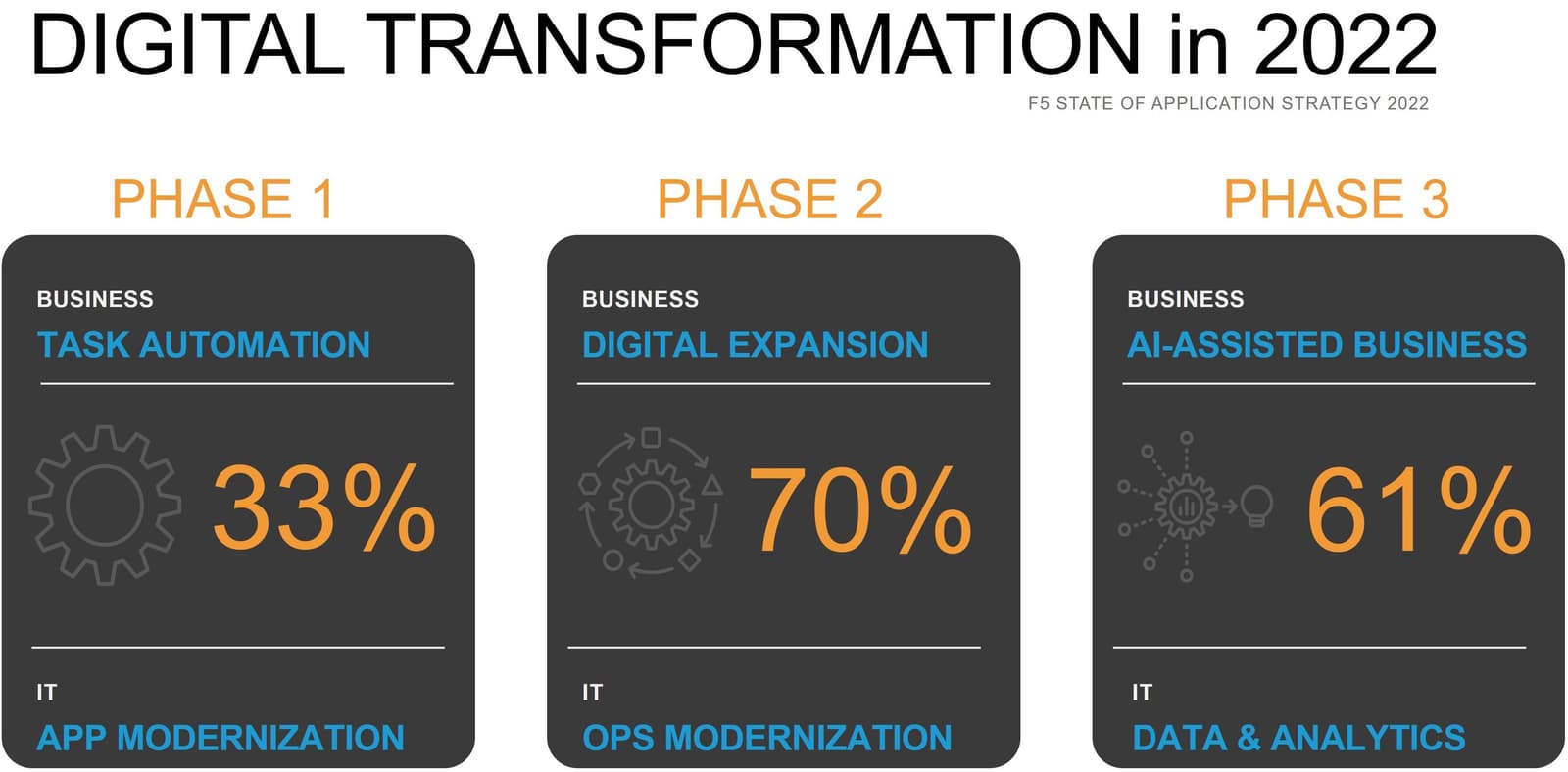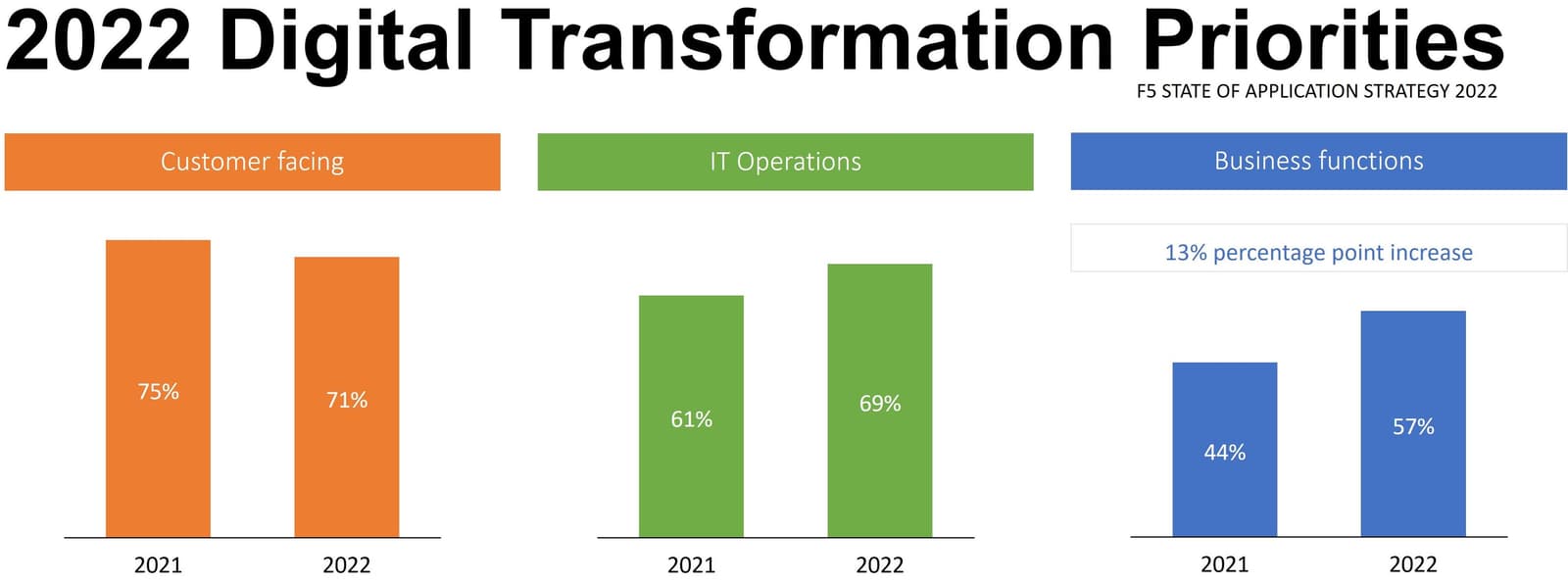As organizations accelerate their journey to become a digital business, CIOs are taking the wheel and kicking the technology engine into high gear to power organizations through the second phase of digital transformation with a shift in focus from modernizing apps to modernizing ops.
The ability of organizations to sustain their accelerated rate of digitization is about to face its biggest challenge—IT. While we’ve seen great strides in the transformation of customer-facing experiences, motivated by necessity, businesses are beginning to realize that becoming a fully digital business means transformation of the entire business. That yellow flag on the race to dominate in a digital economy is causing a shift in focus toward business functions and IT operations, putting CIOs in the driver’s seat.
Digital transformation is a journey made of many smaller journeys
For the past three years, we’ve analyzed our annual research through the lens of the digital transformation journey. While the journey takes organizations through three distinct phases, the reality is that most organizations—63%—are operating in multiple phases at the same time. Just over one in three is currently focused on a single phase. Almost one in five—18%—are currently operating in all three phases.

In the past, we’ve focused primarily on the business side of digital transformation. But this year we see serious attention now being paid to the other side of the equation: technology. That’s likely due to roadblocks and potholes organizations have encountered as they focus on modernizing apps to support the digital experiences necessary to thrive in this digital as default world. Expanding to cloud—the rate of SaaS adoption continues unabated and there are signs Everything-as-a-Service (XaaS) will play a significant role in the future—introduces technology challenges that can only be answered by IT.
Modernizing Apps
Business processes necessarily span many lines of business and cross organizational boundaries into less mentioned areas such as legal, HR, and finance. A telling result in this year’s research is significant growth in the focus on digitizing these functions.
Customer-facing experiences are still a priority, but organizations are facing the reality of cross-functional processes: traditional (manual) steps in a process are disruptive, slow, and prone to degrade the digital experience for customers, partners, and employees.

A focus on business functions necessarily means a renewed focus on applications. That’s sent some back to phase one—task automation—to focus on modernizing apps and building (or subscribing) to new apps to digitize those functions that remain manual and paper-based. A significant majority—88%—are modernizing applications and 17% of the average app portfolio is SaaS today.
But it’s not just modernization of the apps themselves that is driving organizations to look inward to maintain momentum. More than eight in ten (84%) organizations plan to deploy workloads at the edge. That should be unsurprising, as many of those workloads are traditionally deployed at the edge such as performance and monitoring related services like caching, CDNs, and health monitoring. What is surprising is the number of organizations who plan to deploy application (42%) and data workloads (42%) at the edge. That demand means the rate at which the shift in the edge ecosystem must occur to accommodate these workloads must accelerate. Dramatically.
It also means IT will face even greater challenges as workloads distribute even further from the data center core. Multi-cloud will expand to include edge and magnify existing challenges with operations.
The consequence of an expanded portfolio distributed across even more locations is a greater need for operations and a focus on sustaining the best possible digital experience for users. It means modernizing ops.
Modernizing Ops
The answer is not more ops. Even if organizations weren’t faced with a highly competitive market for technology professionals, throwing more people at a problem tends to produce greater delays and confusion, not faster execution. That’s because more people increase communication channels and, ultimately, cause confusion that translates into delays that impact delivery, deployment, and resolution when incidents inevitably occur.
Automation is generally accepted as the path to more efficient operations and leads to the conclusion that AIOps is inevitable.
While AIOps is the least likely to be in use or planned use with respect to operations, it is still on the radar for more than half (52%) of all respondents this year.
Given the significant challenges faced by IT today with respect to automation, AIOps is an option that cannot be ignored, especially given the rise in automation-related skillset deficits cited by every organization.

While AIOps is certainly not being left behind, CIOs and technology leaders recognize that technology alone is never enough. The purpose of technology is to improve the human capacity to manage, analyze, and make decisions at scale. In the case of AIOps, that means two things. First, offloading mundane operational decisions to automation. This includes actions like auto-scaling and failover. Operational tasks that are well-understood and well-defined. Second, AIOps can increase the speed with which information is delivered to the right people.
And the ‘right people’ increasingly appears to be site reliability engineering (SRE) resources. More than three-quarters of organizations have adopted or plan to adopt SRE operations. And when we look at plans for AIOps through that lens we find a clear connection: those who have adopted or plan to adopt SRE are five times as likely to use or plan to use AI in an operational capacity. The impact on the automation skills deficit is staggering. Organizations that have or plan to adopt SRE operations cited skills deficits at nearly half the rate of those who are sticking with traditional operational models.
Conclusion
The conclusion of our 2022 research is clear: CIOs and technology leaders need to focus on modernizing operations in order to maintain the pace of digital transformation—or risk the consequences of falling behind more digitally mature competitors.
Without a strong, flexible, and modern operational practice, IT will struggle to maintain progress toward a fully digital business powered by AI, data, and automation. This will become even more clear in subsequent blogs as we explore results related to insights (spoiler: still a significant problem) and enterprise initiatives and projects around data, security, and edge computing.
For more, download your own copy of our 2022 State of Application Strategy report.
Check out related blogs for deeper dives on select topics:
State of Application Strategy 2022: Unpacking 8 Years of Trends ›
State of Application Strategy 2022: Security Shifts to Identity ›
State of Application Strategy 2022: Edge Workloads Expanding to Apps and Data ›
State of Application Strategy 2022: Digital Innovators Highlight the Importance of Modernizing ›
State of Application Strategy 2022: Multi-Cloud Complexity Continues ›
State of Application Strategy 2022: The Future of Business Is Adaptive ›
State of Application Strategy 2022: Performance Trends ›
About the Author

Related Blog Posts

Multicloud chaos ends at the Equinix Edge with F5 Distributed Cloud CE
Simplify multicloud security with Equinix and F5 Distributed Cloud CE. Centralize your perimeter, reduce costs, and enhance performance with edge-driven WAAP.
At the Intersection of Operational Data and Generative AI
Help your organization understand the impact of generative AI (GenAI) on its operational data practices, and learn how to better align GenAI technology adoption timelines with existing budgets, practices, and cultures.
Using AI for IT Automation Security
Learn how artificial intelligence and machine learning aid in mitigating cybersecurity threats to your IT automation processes.
Most Exciting Tech Trend in 2022: IT/OT Convergence
The line between operation and digital systems continues to blur as homes and businesses increase their reliance on connected devices, accelerating the convergence of IT and OT. While this trend of integration brings excitement, it also presents its own challenges and concerns to be considered.
Adaptive Applications are Data-Driven
There's a big difference between knowing something's wrong and knowing what to do about it. Only after monitoring the right elements can we discern the health of a user experience, deriving from the analysis of those measurements the relationships and patterns that can be inferred. Ultimately, the automation that will give rise to truly adaptive applications is based on measurements and our understanding of them.
Inserting App Services into Shifting App Architectures
Application architectures have evolved several times since the early days of computing, and it is no longer optimal to rely solely on a single, known data path to insert application services. Furthermore, because many of the emerging data paths are not as suitable for a proxy-based platform, we must look to the other potential points of insertion possible to scale and secure modern applications.
